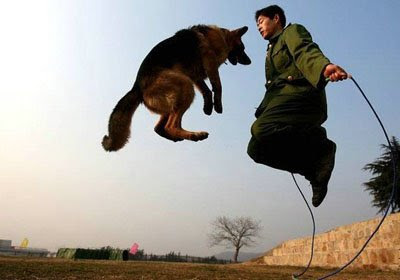
Storytelling with images must be as strong as your script -- plot, dramatic arch and dialogue. Film is a highly visual medium and because the camera was invented to be mobile and has become increasingly moreso as the technology has evolved --use its compactness and mobility to your advantage. As much time as a writer spends on writing, analyzing and rewriting their script, also the artistic team (director, cinematographer, lighting, art director, location manager, wardrobe) should spend pre-visualizing, sketching, and compositing each scene of the short film.
The low angle of the shot above with the dog and man rope jumping in unison makes the act more powerful and impactful. When both the man and certainly the dog rise above the mid-screen line, we feel their effort has been fair more significant than if we we view them from eye level with the horizon above mid-frame. These are important ways to think about your shots and each one is a unique and interesting challenge.
In film courses students are taught how to tell story without words, narration, or verbal exposition. Visual storytelling engages the audience more profoundly than hearing it told by a character or in narration. In every scene, the director, writer and cinematographer need to create the most powerful visual significance to propel emotion, circumstance, and predicament.
 Try to avoid static horizon/ground shots all the time where is camera is on a tripod pointing straightforward, or held at eye height looking at your actors. Think and plan for over head shots, low angels, high angels and camera movement that contribute to telling the story and not just added as an after-thought. Create wonderment and excitement within your frame and build it throughout scenes.
Try to avoid static horizon/ground shots all the time where is camera is on a tripod pointing straightforward, or held at eye height looking at your actors. Think and plan for over head shots, low angels, high angels and camera movement that contribute to telling the story and not just added as an after-thought. Create wonderment and excitement within your frame and build it throughout scenes.Challenge yourself to provide visually stimulating diversity. Take your audiences to places they've never been before with visual perspectives they don't often reach. They will thank you for it and enjoy your film much more immensely.




No comments:
Post a Comment